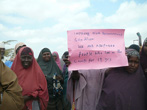Did the aid industry fuel the mayhem in Somalia?

The struggle for peace and security in Somalia, a country bereft of stable governance for more than two decades, has been severely prolonged by the external agencies and donors that form global the aid industry, writes Rasna Warah. Warah takes a look at what lies beyond the smoke screen of collection boxes and celebrity appeals – a distant reality from stolen food supplies and guerrilla warfare.
Somalia celebrates 50 years of independence this week, but many people are wondering whether there is anything worth celebrating.
For more than two decades the country has had no functioning government, and even today the recently elected Somali Transitional Federal Government (TFG) is barely able to carry out its functions effectively, thanks to militia who control many parts of the country.
Relief agencies estimate that nearly 1.4 million Somalis have been displaced since the 1990s, and nearly half the country’s population – more than 3 million people – is still in need of relief aid and assistance.
But this is the story of the Somalia that we all know. The less known story is that of a country that was systematically destroyed by international NGOs, UN agencies and donors who undermined the local economy by flooding Somalia with aid, especially since the fall of Siad Barre in 1991.
No one tells this story better than Michael Maren, a former Peace Corps volunteer, who in his 1997 book, ‘The Road to Hell’, explains how the aid industry in Somalia became ‘a self-serving system that thrived on the chaos in the country’.
His main argument is that the aid industry undermined development in Somalia by stifling the local economy through relief supplies that killed industries, and which were routinely stolen by warlords, merchants and government officials.
Maren states in his book that about two thirds of the food aid was stolen from ships at the docks or after it had been transported to the refugee camps. He witnessed military vehicles leaving camps loaded with bags of food.
He saw merchants’ warehouses filled with bags bearing the slogan ‘Donated by the People of the United States’. Camp commanders – usually soldiers or guerrillas – would often sell the food to buy arms. Stolen food aid fuelled the arms race in the country, with warring factions using it to purchase guns and ammunition, often from the very countries supplying the aid.
Apparently this practice continues to this day. A leaked UN report states that roughly half of the $485 million of aid provided to Somalia by the World Food Programme (WFP) in 2009 has gone to corrupt contractors, rebels and even UN staff members. This is not so unusual. A recent BBC report claims that more than 90 per cent of the money raised by Bob Geldof’s famous 1985 Live Aid concert for famine victims in Ethiopia was siphoned off by rebel fighters.
Maren claims that all the aid agencies in Somalia knew that relief food was being stolen, but neglected to mention this fact in their reports or during fund-raising campaigns because millions of dollars and thousands of jobs were at stake. He says that neither the US Government nor United States Agency for International Development (USAID) officials were interested in his revelations, perhaps because, as this month’s New African magazine suggests, all of the United States’ food aid programmes ‘are designed to develop and expand commercial outlets for US commodities in world markets’.
Journalists, on the other hand, he writes, seemed more concerned about writing of starving children than about how aid was being used to arm militia. Maren asserts that all interventions in Somalia – whether by NGOs, UN agencies or governments – had the unintended impact of financing the destruction of the country.
Maren, who worked as a food monitor for a USAID project in Somalia in the early 1980s, says that many farmers abandoned their land to live in camps, where the food was free and where the opportunities to sell food were greater. This severely impacted on local agricultural production.
Food aid is intimately linked to domestic agricultural production in the US. When there is a surplus, it is shipped off as aid to places like Somalia. A 1988 World Bank discussion paper found that food aid, in turn, often acts to dampen domestic prices, thereby reducing incentives to domestic producers of food crops and exacerbating the food deficit.
Food aid thus eroded Somalia’s economy and made people poorer, thereby creating a cycle of famine, relief, followed by more famine. It is not just food that is being dumped in Somalia. The chaos there has allowed criminals and opportunists to dump all kinds of toxic materials into Somali waters.
According to the United Nations Environment Programme (UNEP) European and Asian vessels and trawlers have been dumping hazardous waste, including radioactive uranium waste, in Somali waters since the 1990s.
The good news (if it can be called that) is that the threat of hijacking by Somali pirates may have temporarily halted this illegal and highly dangerous activity. Ironically, piracy has also revived the country’s fishing industry, which had almost collapsed due to illegal fishing by foreign trawlers.
BROUGHT TO YOU BY PAMBAZUKA NEWS
* This article was originally published by the Daily Nation.
* Rasna Warah is a writer and journalist based in Nairobi and can be contacted at [email protected]
* Please send comments to [email protected] or comment online at Pambazuka News.
